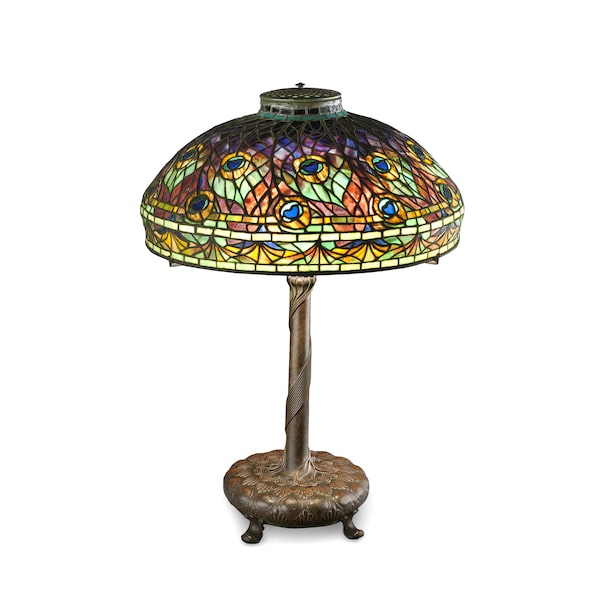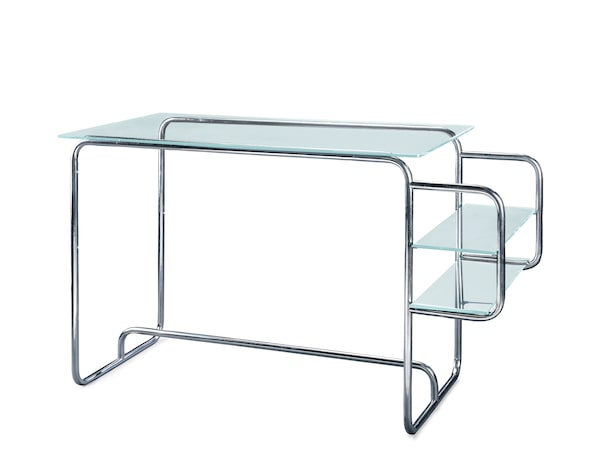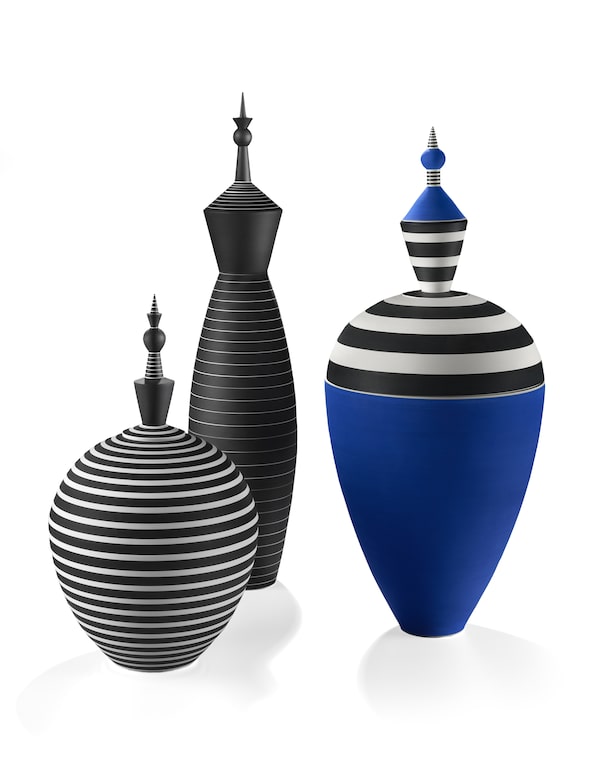Parall(elles): A History of Women in Design at the Montreal Museum of Fine Arts.Denis Farley/MMFA
In the current exhibition of design by women at the Montreal Museum of Fine Arts, the first thing a visitor encounters is a 1958 Corvette. It’s a beautiful thing of sensuous curves and shiny chrome, delighting in a sophisticated paint job of pale silvery green and a soft leather interior.
However, only that detailing was designed by a woman, Ruth Glennie.
Recognizing that women participated in most car purchasing decisions, General Motors decided a feminine touch was required for the paint colours, upholstery and dashboard, and hired six women to provide it. The cars were unveiled at the 1958 Feminine Auto Show in a setting of soft lights, diaphanous fabric streamers and potted hyacinths.
The history of women in design is not exactly a tale of feminist triumph, and this exhibition, which follows their work from the late 19th century to the present, is more eclectic than momentous.
It comes about due to the closure of Montreal’s Musée d’arts decoratifs in 1997 and the donation by its founder, philanthropist Liliane Stewart, of 5,000 industrial and decorative objects from that collection to the MMFA. When the Stewart Program for Modern Design, a successor to the shuttered decorative arts museum, launched a website devoted to female designers in 2020, the idea for a physical exhibition was born. Curator Jennifer Laurent has assembled a display from the Stewart gift and from the MMFA’s own collection, and rounded it out with strategic loans: the Corvette is the only remaining example of work by GM’s so-called “Damsels of Design” and has been lent by a private collector in Germany.
As Laurent notes in her catalogue, if “design” means the industrial design of consumer objects for mass production, then design was and remains a solidly male domain. (And, to be fair, often anonymous, whatever the sex of the designer.) To create this exhibition, which starts with the contribution of women to the Arts & Crafts movement in the late 19th century, the curator must expand her definitions to include craft and home décor, unique objects often made by hand for personal use or private clients.
The exhibition limits itself to American and Canadian objects, because that is mainly what is in the collections, but the British Arts & Crafts movement is a key starting point. Its emphasis on the artisanal, in reaction against industrialization, provided an entrée into the marketplace for female creators and their traditional handicrafts, including jewelry, textiles and ceramics.

Peacock table lamp, about 1905, made by Tiffany Studios, New York, designed by Clara Driscoll (1861-1944).MMFA
The movement’s influence spread to North America and it is represented here by some stunning early 20th century ceramics from various Boston potteries, including vases by Marie Seaman, Annie E. Aldrich and Wilhelmina Post, and a 1905 Tiffany peacock lamp designed by Clara Driscoll. She has only been recognized as the chief designer of the famed Tiffany lamps in the 21st century, but was well compensated in her day because Louis Comfort Tiffany paid his female assistants as much as the men.
Women’s role in the Arts & Crafts movement could probably make an exhibition all on its own, and from that strong introduction the show proceeds by fits and starts with several other areas that might also profit from a more focused look. There is small display of largely anonymous Indigenous quill work, basketry and beadwork (including an impressive cradle by Mary Christianne Paul Morris) made for the tourist trade that raises questions about the history of traditional Indigenous crafts after European contact.
And, as evidence of the professionalization of what used to be called decorating, there are two wildly contrasting examples of interior design. Less than 20 years after Elsie de Wolfe invented the field with her ornate antique-stuffed Louis XV style for the Henry Clay Frick house in New York, Jeannette Meunier Biéler’s designed her own Montreal apartment with striking modernist simplicity.

Jeannette Meunier Biéler (1900-1990), desk, about 1932-1933.Krause, Johansen/MMFA
There are some remarkable objects here from the Art Deco and early modernist period, including Biéler’s glass and chrome desk, Elizabeth Eyre de Lanux’s unusual swinging bed and several notable tea and coffee services, including one in white porcelain by Eva Zeisel and a nesting one in silver plate by Virginia Hamill and Jean G. Theobald intended for a diner. There is not, however, much sense of an emerging narrative.

Greta Magnusson-Grossman (1906-1999), desk, about 1952, produced by Glenn of California, Arcadia.Courtesy of R & Company
That lack becomes particularly apparent in the room devoted to mid-century modernism where a conventional (male) history of design could be expected to reach a crescendo of functional form. Here there are nice examples, such as Greta Magnusson-Grossman’s good-looking walnut desk, Florence Knoll’s admirably functional double letter tray, and a trio of lovely ceramic bottles by the Montreal potter Rose Truchnovsky. There is also one example of the famous Eames chairs, designed by the husband-and-wife duo of Charles and Ray Eames, but no word yet that women designers are coming into their own.
Perhaps the most unusual object on display is an electric impact wrench designed by Aileen Bushnell in Illinois in 1949: Women were never known as designers of industrial tools and curators would be hard pressed to find other examples. On the other hand, a small display about the craft movements of the sixties and seventies again suggests an area that might deserve more attention.
Not coincidentally, it’s in the next room, devoted to postmodern design, that there is a sudden eruption of creativity and this show belatedly takes flight. In the era of second-wave feminism, postmodernism’s eclecticism made new space for women designers. It allowed them to import the crafts aesthetic revived in the sixties into the mass market and permitted a riotously decorative approach to design that cleaner and sparser modernist styles had precluded. Highlights here, from the 1970s, 80s and 90s, include a few prototypes for the ceramic plates of Judy Chicago’s The Dinner Party, that art installation featuring table settings for historical and mythical heroines; a flattened Queen Anne chair by the Philadelphia architects Denise Scott Brown and Robert Venturi, a jacket made to look like ivy with pants like a tree trunk by Adelle Lutz, and stripped porcelain jars with lids shaped like minarets by Roseline Delisle.
Denise Scott Brown (born in 1931) and Robert Venturi (1925-2018), Queen Anne chair, 'Grandmother’s Tablecloth' pattern, 1984 (example of 1985), produced by Knoll International, New York.MMFA
It’s interesting to compare this exhibition to the Canadian Modern show now at the Royal Ontario Museum in Toronto. There, in the midst of a display of admirable modernist objects efficiently and stylishly designed (including both textiles and ceramics designed by women), postmodernism reads as a rather silly footnote full of gimmickry and mere decoration. Here, on the other hand, as pots take the shape of buildings or clothes are made to look like trees, postmodernism comes across as a particularly fertile style for female designers, unleashing them from the restraints of modernism, allowing more figurative content, witty referentiality and decorative motifs in ways that could play to the marketplace.

Roseline Delisle (1952-2003), covered jars: Quadruple 9.95, 1995; Quadruple 7 Paratonnerre, 1989; Triptych 12.95, 1995.MMFA
The exhibition ends with a display of contemporary design so multidisciplinary, including everything from ergonomic kitchen utensils and edible takeout food containers to decorative sleeves for prosthetics, you have to figure female designers have finally arrived. Still, Laurent cautions that while women now make up the majority of students in design programs, only a very few work as product or industrial designers or reach the top of the field.
Potentially, gender parity amongst designers would lead to more gender equity in the production of everyday things, so often designed for a male norm. Aside from soft lighting or pretty flowers, there are all kinds of characteristics that women might specifically require from industrial design. Still, in the midst of a collection featuring the rare and the beautiful, that’s a topic for another day.
Parall(elles): A History of Women in Design continues at the Montreal Museum of Fine Arts to May 28.
 Kate Taylor
Kate Taylor